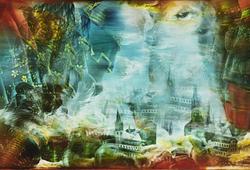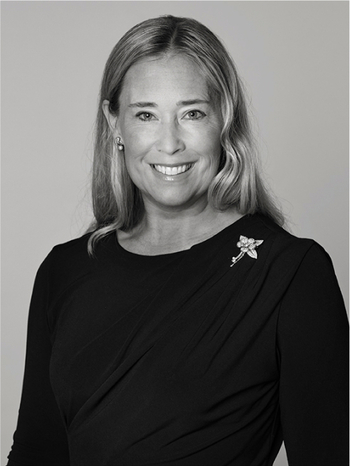A rare doucai dragon medallion jar, Qing dynasty, Yongzheng mark and of the period (1723-35).
The finely potted ovoid body rising from a tapered foot to a rounded shoulder and an upright rim, painted around the exterior with five dragon medallions, each enclosing a five-clawed dragon writhing amongst cloud scrolls, its arm extended reaching for a flaming pearl, interspersed with clusters of multi-coloured cloud scrolls, all above a lappet border above the foot, the shoulder painted with bajixiang above a stylised cloud scroll in green enamel, the base inscribed with a six-character mark in underglaze blue. Height 18.6 cm. Wooden stand and cover accompanies the jar, height with them 24 cm.
Kinstugi restored. Star crack.
Alkuperä - Provenienssi
Gustaf Oscar Wallenberg (1865-1937), Stockholm, and thence by descent within the family.
Gustaf O. Wallenberg was a Swedish businessman, diplomat and active politician. He was the son of André Oscar Wallenberg, founder of Stockholm Enskilda Bank (today's Skandinaviska Enskilda Banken, known as SEB). After a career in the Swedish Navy he turned to the business world and was active in improving the transoceanic shipping industry.
Wallenberg was Sweden's Envoy to Tokyo between 1907-1918. In April 1907 he travelled to Beijing to amend the Treaty of Canton (1847) between Sweden-Norway and China and to establish diplomatic relations between Sweden and the Qing Court. As the Swedish Envoy Extraordinary and Minister Plenipotentiary at the Court of Peking, he successfully negotiated and signed with Lien Fang, the Guangxu Emperor's High Commissioner Plenipotentiary and Senior Vice-President of the Wai Wu Pu, the Treaty of Amity, Commerce and Navigation, between Sweden and China, which was signed in Beijing on 2 July 1908, with an additional article signed on 24 May 1909.
The collection was acquired between 1907 and 1918 when Wallenberg was the Swedish Envoy in Tokyo, and possibly during his diplomatic service in China. Documents preserved at the Östasiatiska Museum in Stockholm demonstrate the importance of Gustaf Wallenberg and his extensive connections with the Qing government to the Swedish engineers and businessmen who were in China during this period, such as Johan Gunnar Andersson, Osvald Siren, Orvar Karlbeck, Erik Nordstrom and many more.
Gustaf Wallenberg was the grandfather of Raoul Gustaf Wallenberg (1912-1945), an architect, businessman, and diplomat. Raoul Wallenberg has been designated by Yad Vashem as one of the Righteous Among Nations, as well as having many monuments and streets named after him in honour of him saving thousands of Jews in German-occupied Hungary during the Second World War, while serving as Sweden's Special Envoy in Budapest. As he lost his father the same year he was born, he was brought up also by his grandfather Gustaf Wallenberg, with the Chinese porcelain collection around him, inheriting part of the collection when his grandfather passed away in 1937. He died at a time unknown between 1945 and 1947, further to his detention in Budapest by General Malinovsky in 1944, and arrest by the Soviet authorities. Further to his disappearance his part of the Chinese collection was deposited at the Östasiatiska Museum in Stockholm, and later released to the family.
Näyttelyt
Compare; a closely related jar from the collection of Sir Augustus Wollaston Franks, in the British Museum, London (accession no. Franks.338), illustrated in Sekai toji zhenshu/Ceramic Art of the World, vol. 15, Tokyo, 1983, pl. 195.
Compare also one in the Victoria and Albert Museum, London (accession no. 605-1907).
Compare also, Christies, 3566, 1 Jun 2011 Live auction 2861. The Imperial Sale.
Compare also, Sothebys, lot not 12. Imperial Porcelain – A Private Collection
4 November 2020, London.
Kirjallisuus
For a prototype of this form and design, see a Chenghua mark and period covered jar with floral roundels, from the Qing court collection and still in Beijing (accession no. 00115586), illustrated ibid., pl. 168; and a reconstructed cup with roundels of winged dragons, excavated from the Chenghua stratum at the waste heaps of the imperial kiln factory in Jingdezhen, included in the exhibition A Legacy of Chenghua. Imperial Porcelain from the Chenghua Reign Excavated from Zhushan, Jingdezhen, Tsui Museum of Art, Hong Kong, 1993, cat. no. C120.
Muut tiedot
This jar is particularly notable for its delicately painted motif of dragon roundels in soft washes of coloured enamel outlined and detailed in cobalt. The motif and colour scheme draws from imperial porcelain of the Chenghua period (r. 1465-1487), adapted and reinterpreted in accordance to contemporary taste. A Yongzheng innovation is evident in the use of cobalt not only to delineate the different elements of the design but also to create texture and a sense of movement through the dragons’ fine network of scales and their manes.
Chenghua polychrome porcelain provided much inspiration to the potters active at the imperial kilns during the Yongzheng period as these early wares were particularly treasured by the emperor. An official record from 1732 lists 57 porcelain designs that were to be produced by the imperial kilns and mentions Chenghua polychrome porcelain among the most admired wares of the past. While masterpieces of the past were at times sent to Jingdezhen and used as models for direct copying, the most successful Yongzheng wares are contemporary interpretations of classic designs. This piece is such a creation: dragon roundels are known on Chenghua porcelain but are seldom found on jars, and the rendering of the dragons are characteristic of the Qing period.






















































